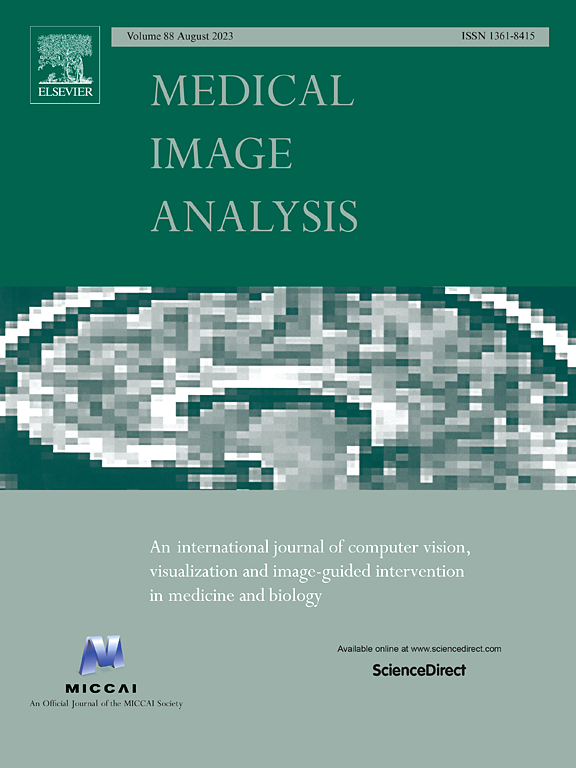Hashimoto’s thyroiditis recognition from multi-modal data via global cross-attention and distance-aware training
IF 10.7
1区 医学
Q1 COMPUTER SCIENCE, ARTIFICIAL INTELLIGENCE
引用次数: 0
Abstract
Ultrasound images and biological indicators, which reveal Hashimoto’s thyroiditis (HT) characteristics in thyroid tissue from different perspectives, play crucial roles in HT recognition. Ultrasound images of patients with HT typically present a heterogeneous background with potential decreases in echogenicity. Clinicians are prone to misdiagnosing HT by visually evaluating these characteristics. In addition, patients with HT may exhibit fluctuations in relevant biological indicators, but there are no absolute relationships between a single biological indicator and HT. To address these challenges, we propose HTR-Net, a novel HT recognition network that combines ultrasound images and biological indicators through multi-modality information embedding. Specifically, HTR-Net introduces a global cross-attention module (GCA), which enhances recognition of the heterogeneous background with potential decreases in echogenicity. A distance-aware mismatched augmentation (DMA) strategy is also designed to expand the limited biological indicator data and ensure reasonable values for the augmented biological indicators, thus enhancing the model performance. In order to address the nonabsolute relationship between HT and a single biological indicator, we propose a distance-aware loss (DL) function to constrain feature mapping for effective information extraction from indicators, thereby enhancing the model’s capability to detect anomalous sets of biological indicators. To validate the proposed method, we construct a multi-center HT dataset and conduct extensive experiments. The experimental results demonstrate that the proposed HTR-Net achieves state-of-the-art (SOTA) performance.

通过全球交叉注意和距离感知训练从多模态数据识别桥本甲状腺炎
超声图像和生物指标从不同角度揭示了桥本甲状腺炎(Hashimoto’s thyroiditis, HT)在甲状腺组织中的特征,在HT识别中起着至关重要的作用。HT患者的超声图像通常呈现不均匀背景,回声性可能降低。临床医生通过视觉评估这些特征容易误诊HT。此外,HT患者的相关生物学指标可能出现波动,但单一生物学指标与HT之间并不存在绝对关系。为了解决这些挑战,我们提出了HTR-Net,这是一种新型的HT识别网络,通过多模态信息嵌入将超声图像和生物指标结合起来。具体来说,HTR-Net引入了一个全局交叉注意模块(GCA),增强了对具有潜在回声性降低的异质背景的识别。设计了距离感知错配增强(DMA)策略,对有限的生物指标数据进行扩展,保证增强后的生物指标值合理,从而提高模型性能。为了解决HT与单个生物指标之间的非绝对关系,我们提出了一个距离感知损失(DL)函数来约束特征映射,以便从指标中有效地提取信息,从而增强模型检测异常生物指标集的能力。为了验证所提出的方法,我们构建了一个多中心的HT数据集并进行了大量的实验。实验结果表明,提出的HTR-Net达到了最先进(SOTA)的性能。
本文章由计算机程序翻译,如有差异,请以英文原文为准。
求助全文
约1分钟内获得全文
求助全文
来源期刊

Medical image analysis
工程技术-工程:生物医学
CiteScore
22.10
自引率
6.40%
发文量
309
审稿时长
6.6 months
期刊介绍:
Medical Image Analysis serves as a platform for sharing new research findings in the realm of medical and biological image analysis, with a focus on applications of computer vision, virtual reality, and robotics to biomedical imaging challenges. The journal prioritizes the publication of high-quality, original papers contributing to the fundamental science of processing, analyzing, and utilizing medical and biological images. It welcomes approaches utilizing biomedical image datasets across all spatial scales, from molecular/cellular imaging to tissue/organ imaging.
 求助内容:
求助内容: 应助结果提醒方式:
应助结果提醒方式:


